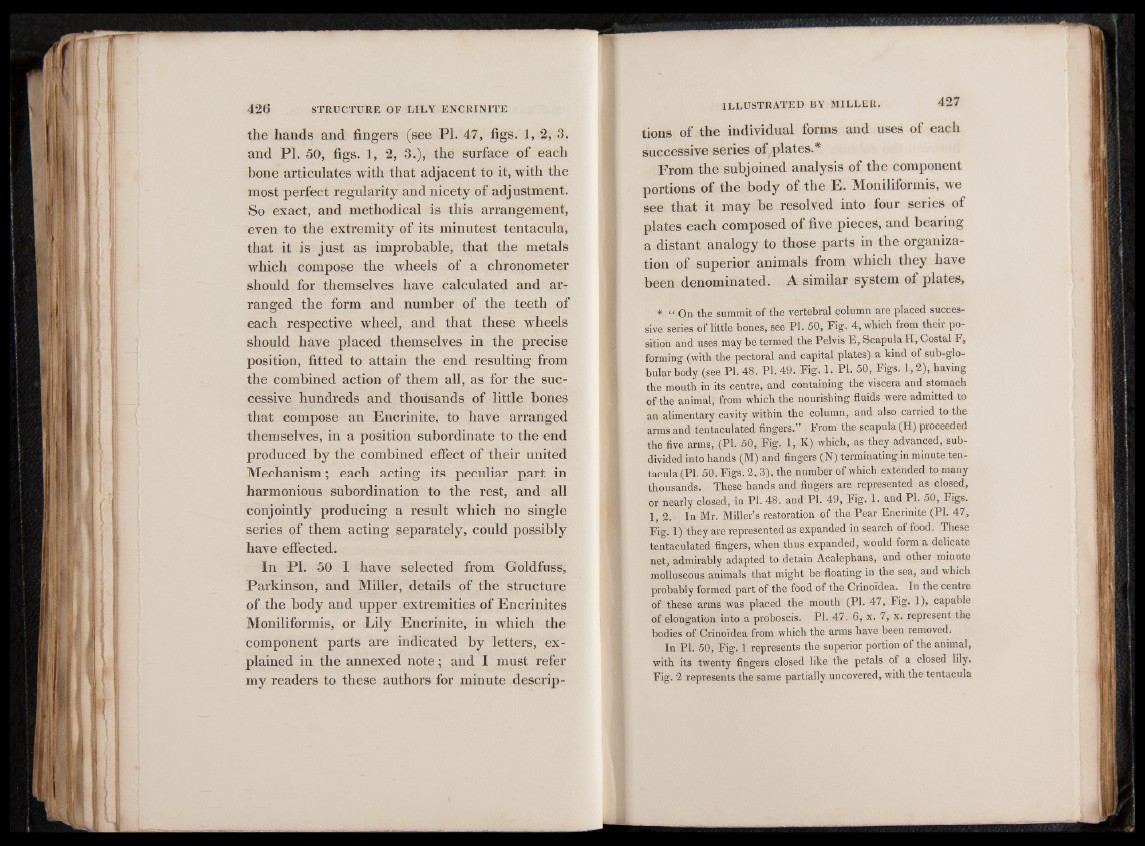
the hands and fingers (see PI. 47, figs. 1, 2, 3.
and PI. 50, figs. 1, 2, 3.), the surface of each
bone articulates with that adjacent to it, with the
most perfect regularity and nicety of adjustment.
So exact, and methodical is this arrangement,
even to the extremity of its minutest tentacula,
that it is just as improbable, that the metals
which compose the wheels of a chronometer
should for themselves have calculated and arranged
the form and number of the teeth of
each respective wheel, and that these wheels
should have placed themselves in the precise
position, fitted to attain the end resulting from
the combined action of them all, as for the successive
hundreds and thoüsands of little bones
that compose an Encrinite, to have arranged
themselves, in a position subordinate to the end
produced by the combined effect of their united
Mechanism; each acting its peculiar part in
harmonious subordination to the rest, and all
conjointly producing a result which no single
series of them acting separately, could possibly
have effected.
In PI. 50 I have selected from Goldfuss,
Parkinson, and Miller, details of the structure
of the body and upper extremities of Encrinites
Moniliformis, or Lily Encrinite, in which the
component parts are indicated by letters, explained
in the annexed note; and I must refer
my readers to these authors for minute descriptions
of the individual forms and uses of each
successive series of plates.*
From the subjoined analysis of the component
portions of the body of the E. Moniliformis, we
see that it may be resolved into four series of
plates each composed of five pieces, and bearing
a distant analogy to those parts in the organization
of superior animals from which they have
been denominated. A similar system of plates,
* “ On the summit of the vertebral column are placed successive
series of little bones, see PI. 50, Fig. 4, which from their position
and uses may be termed the Pelvis E, Scapula H, Costal F,
forming (with the pectoral and capital plates) a kind of sub-globular
body (see PL 48. PI. 49. Fig. jk PL 50, Figs. 1 ,2 ), having
the mouth in its centre, and containing the viscera and stomach
of the animal, from which the nourishing fluids were admitted to
an alimentary cavity within the column, and also carried to the
arms and tentaculated fingers.” From the scapula (H) proceeded
the five arms, (PL 50, Fig. 1, K) which, as they advanced, subdivided
into hands (M) and fingers (N) terminating in minute tentacula
(PL 50. Figs. 2, 3), the number of which extended to many
thousands. These hands and fingers are represented as closed,
or nearly closed, in PL 48. and PL 49, Fig. 1. and Pl. 50, Figs.
1, 2. In Mr. Miller’s restoration of the Pear Encrinite (Pl. 47,
Fig. 1) they are represented as expanded in search of food. These
tentaculated fingers, when thus expanded, would form a delicate
net, admirably adapted to detain Acalephans, and other minute
molluscous animals that might be floating in the sea, and which
probably formed part of the food of the Crinoidea. In the centre
of these arms was placed the mouth (PL 47, Fig. 1), capable
of elongation into a proboscis. PL 47. 6, x. 7, x. represent the
bodies of Crinoidea from which the arms have been removed.
In PL 50, Fig. 1 represents the superior portion of the animal,
with its twenty fingers closed like the petals of a closed lily.
Fig. 2 represents the same partially uncovered, with the tentacula